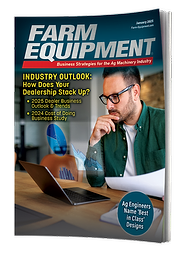Whether your dealership has 1 store or 21 stores, developing your next generation of leaders at all levels is critical for the future success of the business. A lot of attention is often given to recruiting new employees, but how much attention have you as a leader been giving to developing the employees you already have?
A study conducted by the Western Equipment Dealers Assn. shows 46% of dealers said they were not confident they have the bench strength to advance current staff into senior or mid-level management roles. The articles that follow break down how different dealerships are approaching their leadership and employee development. While all of them are taking slightly different approaches, one common theme is you have to be proactive in developing your staff.
Developing and training your people are two different things with two different purposes. Zach Hetterick, former dealer executive and now a coach and consultant with Harvesting Potential and the Machinery Advisors Consortium, says training plays a significant part in development; however, training is usually in the management spectrum. It focuses on financial metrics, business processes, a technical skill or the employee’s role, and completed in a one size fits all approach. Everyone in the training gets the same content no matter where they are in their development or their level of experience.
“I have experienced this firsthand and heard it said many times ‘I sent my people to training and they returned and no meaningful impact occurred,’” Hetterick says.
This is where the difference in training and development exist, and how leadership ties into the equation.
The only way to sustainably grow the leadership levels of you or your organization is to establish a culture of development and growth. Development is based on developing the person, it isn’t a program that you can attend and come home as a leader after two or three days, he says.
An important distinction many of the dealers made when discussing their development programs is that a leader does not need to be a manager. And you need leaders in your business who aren’t managers. They can carry your brand and culture and spread that message to both your other employees and the customers.
“If you want to build your bench and grow your footprint seamlessly, you’ve got to become an expert at succession management,” says Josh Waggener, president of Hutson Inc., a 30-store John Deere dealer based in Kentucky. “If you want to build your bench, grow your footprint, increase your retention rate, grow your bottom line, be an employer of choice, be a force to be reckoned with, build an army that will run behind you no matter where you go. You’ve got to do it with an infinite-minded bench.”
What’s an infinite-minded bench? It’s an organization that seeks strategies around valuing employees. It’s a dealership that measures engagement as well as financials. And, Waggener says, it means desiring to be valued, empowered and part of a bigger purpose.
Facing Reality: Dealers Must Develop Their Own Home-Grown Talent Why Executives Should Train the Next Generation of LeaderDeveloping Leaders Takes Time but Yields Big ResultsHow to Identify, Develop & Retain Your Dealership’s Next Generation of LeadersLeadership Development Must Be ProactiveCollege Recruitment Programs Help Alleviate Hiring Crunch






